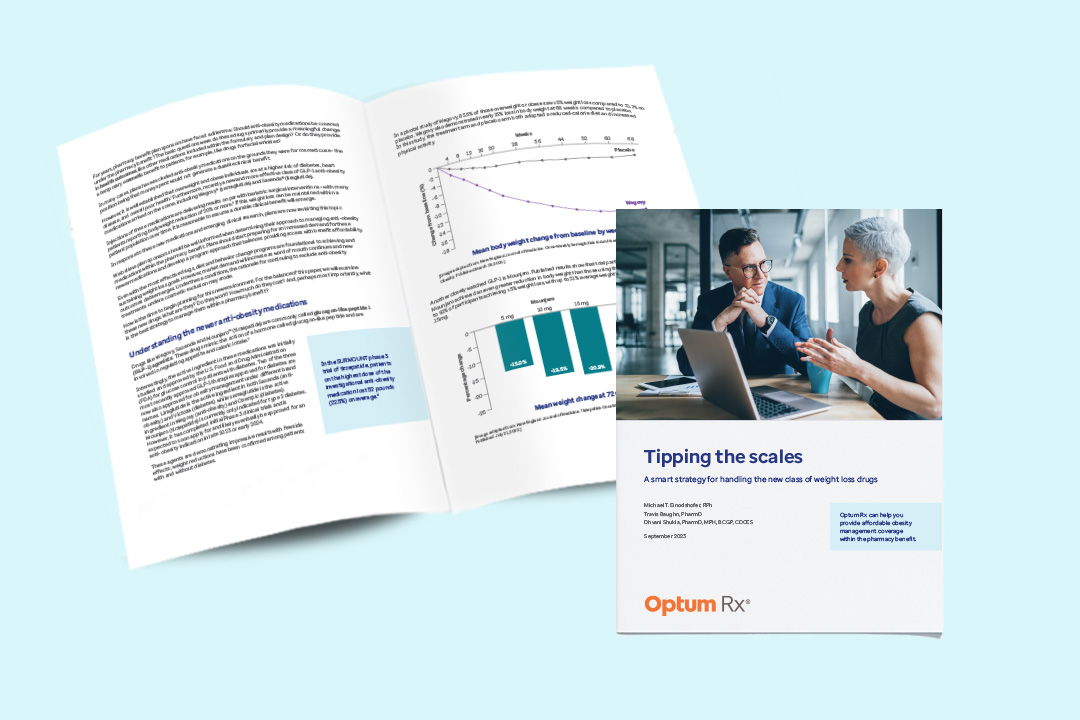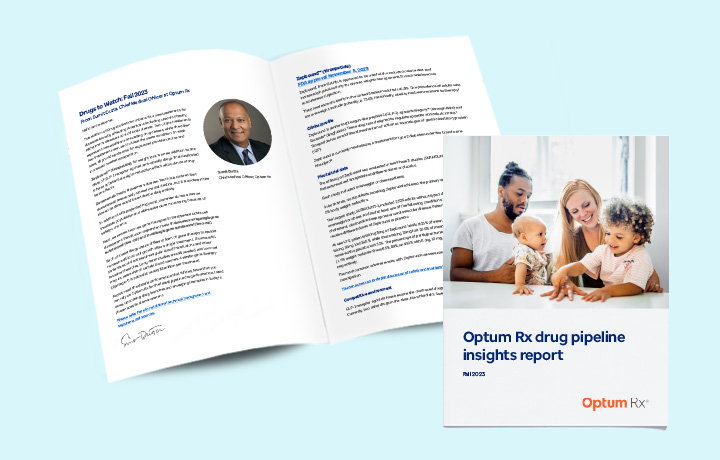
Sumit Dutta, MD
Chief Medical Officer
Drugs to Watch: Fall 2023
Hello and welcome.
This edition of Drugs to Watch contains 4 new treatments for diseases broadly affecting Americans including chronic obesity, Alzheimer’s disease and sickle cell disease. Two of the treatments represent new additions to existing drug classes, while the other 2 treatments are used to treat the same condition. In each case, all provide potential for expanded provider choice and increased market competition.
Zepbound™ (tirzepatide), for weight loss, is a new addition to the class of GLP-1 receptor agonist anti-obesity drugs. Trials indicated it has a substantial weight-reduction effect with unknown long-term effects.
Donanemab treats Alzheimer’s disease. Test trials showed that donanemab measurably slowed mental decline, but it is unclear if the slowed decline would be evident in daily activity.
In addition to its projected high cost, donanemab has a narrow treatable population and will require close monitoring because of safety concerns.
Next, we review two new gene therapies to treat severe sickle cell disease and transfusion-dependent beta thalassemia: exagamglogene autotemcel (exa-cel) and lovotibeglogene autotemcel (lovo-cel).
Each of these drugs uses a different form of gene therapy to restore normal red blood cell growth after a single treatment. If successful, patients would not require regular blood transfusions and other invasive therapies. Long-term studies are still needed, and lovo-cel may increase risk of certain blood cancers. A similar gene therapy (Zynteglo®) is priced at nearly $3 million per treatment.
As you read the detailed information that follows, know that you can rely on Optum Rx for the latest pipeline drug information, trend news, upcoming drug launches and emerging therapies in today’s pharmaceutical environment.
Get additional technical background and supplemental sources.
Sumit Dutta, MD
Chief Medical Officer
Optum Rx
Zepbound™ (tirzepatide)
Zepbound, from Eli Lilly, is approved to be used with a reduced calorie diet and increased physical activity for chronic weight management. It is administered via subcutaneous injection.
The prevalence of obesity in the United States in adults is 41.9%. The prevalence of adults who are overweight, including obesity, is 73.6%. Historically, obesity has been resistant to therapy.1
Clinical profile
Zepbound is similar to glucagon-like peptide 1 (GLP-1) agonists Wegovy® (semaglutide) and Saxenda® (liraglutide). These drugs are designed to regulate appetite and caloric intake.2 Tirzepatide has an additional mechanism of action as an analogue of gastric inhibitory protein (GIP).
Zepbound is currently marketed as a treatment for type 2 diabetes under the brand name Mounjaro®.
Pivotal trials
The efficacy of Zepbound was evaluated in two Phase 3 studies (SURMOUNT-1 and -2). Patients received tirzepatide at different doses or placebo.
Each study included overweight or obese patients.
In both trials, most patients receiving Zepbound achieved the primary endpoint threshold of ≥ 5% body weight reduction.
The largest study, SURMOUNT-1, included 2,539 adults without type 2 diabetes who were overweight or obese, and had at least one of the following conditions: hypertension, elevated cholesterol, obstructive sleep apnea or cardiovascular disease. Patients were randomized to receive different doses of Zepbound or placebo.
At week 72, patients taking 5 mg of Zepbound had lost 15% of mean body weight. Those taking 10 mg lost 19.5%, while those taking 15 mg lost 20.9% of mean body weight. Those who received the placebo lost 3.1%. The percentage of participants meeting the primary endpoint (≥ 5% weight reduction) was 85%, 89%, and 91% with 5 mg, 10 mg, and 15 mg of Zepbound, respectively.
The most common adverse events with Zepbound use were nausea, diarrhea, vomiting and constipation.
Access an in-depth discussion of safety and trial data on page 6 of our RxOutlook.
Competitive environment
GLP-1 receptor agonists have become the most-used drugs for chronic weight management. Currently, two other drugs in the class, Novo Nordisk’s Saxenda® and Wegovy®, are approved for obesity treatment. The main differentiator for Zepbound is that compared indirectly, it provides a greater percentage reduction in body weight. For example, Wegovy demonstrated a 12.4% reduction in body weight in similar studies vs. 17.8% for the highest dose of Zepbound.
Zepbound may provide highest reductions in body weight, but unlike existing drugs in the class, cardiovascular outcomes data are not yet available. Eli Lilly expects results from a Phase 3 cardiovascular outcomes study in 2024.
In addition to competing with the existing treatment options, other drugs are currently in development for weight loss, including oral semaglutide, which could come to market in 2024.
The announced list price for Zepbound is $12,720 per year. For reference, the Wholesale Acquisition Cost (WAC), which is the manufacturer’s list price for a treatment when sold to wholesalers or direct purchasers, for Wegovy is approximately $17,500 per year.
Expected FDA decision: March 2024
Donanemab, made by Eli Lilly, is under review for the treatment of mild cognitive impairment due to Alzheimer’s disease, and mild Alzheimer’s disease. It is administered via intravenous infusion.
Alzheimer’s disease is an irreversible brain disorder that slowly destroys memory and cognition. Mild cognitive impairment is usually the first sign of Alzheimer’s disease, which then progresses to dementia related to Alzheimer’s disease. The disease is characterized by changes in the brain, including the abnormal accumulation of toxic amyloid beta plaque.
Alzheimer’s disease is the most common form of dementia. It affects about 6.5 million people in the United States and is the fifth-leading cause of death among adults aged 65 years or older.
Clinical profile
Donanemab belongs to a class of medications called beta-amyloid targeted monoclonal antibodies. Other medications in this class include Aduhelm® (aducanumab-avwa) and Leqembi® (lecanemab-irmb). As noted, Alzheimer’s disease causes beta-amyloid plaques to accumulate in the brain, where it can disrupt communication between brain cells and eventually cause them to die. Anti-amyloid drugs function by removing the amyloid plaques.
Pivotal trial data
Donanemab was evaluated in a randomized study (TRAILBLAZER-ALZ 2). Enrolled patients had early symptomatic Alzheimer’s disease (mild cognitive impairment/mild dementia) with low, medium or high amyloid and tau protein levels. Patients were randomized to receive donanemab or placebo for 72 weeks.
The primary endpoint measured change from baseline to 76 weeks on the integrated Alzheimer’s Disease Rating Scale (iADRS), which measures cognition and activities of daily living.
- For subjects with low/medium tau levels, changes in the iADRS score indicate a 35.1% slowing of disease progression, compared to placebo.
- In the overall population (low/medium and high tau), changes in the iADRS represent a 22.3% slowing of disease progression.
Secondary endpoints measured cognitive and functional decline on additional metrics, including on the Clinical Dementia Rating–Sum of Boxes. For this score, those of the overall population (low/medium and high tau) treated with donanemab slowed cognitive functional decline by 29%.
The most common adverse events with donanemab use were amyloid-related imaging abnormalities (ARIA), infusion-related reactions and hypersensitivity.
Access an in-depth discussion of safety and trial data on page 8 of our RxOutlook.
Competitive environment
Currently, Leqembi is the only drug in this class with a traditional (full) FDA approval. The current FDA review for donanemab is for a traditional approval based on Phase 3 trial data.
The efficacy for donanemab appears comparable to Leqembi. The main difference is that donanemab is administered once every month, while Leqembi is administered once every 2 weeks.
Another differentiator for donanemab is patients can stop taking donanemab if they achieve amyloid clearance. In contrast, Leqembi requires continuous use.
In the donanemab trial, 30% of patients achieved amyloid clearance at 24 weeks, while 76% achieved clearance at 76 weeks.
The recently published Phase 3 trial results demonstrated that donanemab reduced clinical decline, but the benefit was small. Although the reduction was statistically significant compared to placebo, it was less than what would be considered clinically meaningful. Additionally, long-term data are not yet available. An extension trial is ongoing.
Like the other drugs in the class, donanemab is associated with ARIA-related side effects, including brain swelling and microhemorrhages, that require additional provider monitoring. Compared indirectly to Leqembi, ARIA adverse events were higher with donanemab. Three patients who experienced ARIA with donanemab treatment died during the pivotal trial.
Finally, donanemab may face competition with a self-administered, subcutaneous formulation of Leqembi. Eisai/Biogen are expected to file for approval for subcutaneous Leqembi by the end of 2023 or first quarter 2024.
For reference, the WAC for Leqembi is approximately $26,500 per year.
Exagamglogene autotemcel (Brand name: TBD)
Expected FDA decision: December 8, 2023
Exagamglogene autotemcel (exa-cel) is manufactured by Vertex Pharmaceuticals and CRISPR Therapeutics. It is under review for the treatment of severe sickle cell disease and transfusion-dependent beta thalassemia.
Severe sickle cell disease is an inherited blood disorder caused by mutations in the hemoglobin beta gene. These mutations lead to sickle, or crescent-shaped, red blood cells. The sickle shaped cells die early, which can cause anemia.
Additionally, the red blood cells become stiff and sticky and interact with other cells, blocking blood flow which leads to painful vaso-occlusive incidents, the leading cause of hospitalization related to sickle cell disease. They can cause acute pain and lead to additional complications, including arthritis, kidney failure and strokes.3
Severe sickle cell disease affects approximately 100,000 people in the United States.
Beta thalassemia is also an inherited blood disorder caused by genetic mutation. In severe cases, patients with beta thalassemia depend on regular, life-long red blood cell transfusions. They also need iron chelation therapy to remove the excess levels of iron in the body due to repeated blood transfusions.
The lifetime cost of transfusions and chelation therapy is estimated to be $5.4 million.4
Beta thalassemia is less common than severe sickle cell disease, affecting approximately 2,000 individuals in the United States.
Clinical profile
Exa-cel is a form of gene-edited therapy called CRISPR-Cas9. This term refers to various systems that can be programmed to edit DNA at precise locations.5
Exa-cel is based on genetically modifying a patient’s hematopoietic stem cells, which can develop into all types of blood cells. Stem cells are edited outside of the body to produce high levels of fetal hemoglobin. Increased fetal hemoglobin is associated with improved health in patients with severe sickle cell disease and transfusion-dependent beta thalassemia.
Pivotal trials
Severe sickle cell disease
Exa-cel was evaluated in an open-label study in patients ages 12- to 35-years-old with severe sickle cell disease (CLIMB-SCD-121). The primary endpoint was the proportion of patients who did not experience a severe vaso-occlusive crises for at least 12 months.
As of June 2023, 94.1% of trial participants achieved the primary endpoint of freedom from vaso-occlusive crises for at least 12 consecutive months. Additionally, all patients achieved the key secondary endpoint of being free from hospitalizations related to vaso-occlusive crises for at least 12 consecutive months.
Transfusion-dependent beta thalassemia
The CLIMB THAL-111 study evaluated exa-cel in patients with severe transfusion-dependent beta thalassemia. The primary endpoint was the proportion of patients without red blood cell transfusions for at least 12 consecutive months after exa-cel infusion.
As of June 2023, 88.9% of participants achieved the primary endpoint, being transfusion-free for at least 12 consecutive months.
The safety profile of exa-cel was generally consistent with standard of care treatment for severe sickle cell disease.
Access an in-depth discussion of safety and trial data on page 10 of our RxOutlook.
Competitive environment
Historically, the only cure for severe sickle cell disease and transfusion-dependent beta thalassemia was hematopoietic stem cell transplant. However, few people can access bone marrow transplantation because matching donors are rare. In August 2022, the FDA approved the bluebird bio gene therapy, Zynteglo® (betibeglogene autotemcel), for transfusion-dependent beta thalassemia.
Zynteglo uses a different method of gene therapy, so exa-cel would be the first approved CRISPR/Cas9 gene-edited therapy competitor to Zynteglo and lovo-cel (see below).
Like Zynteglo, exa-cel would be a one-time treatment and alternative to stem cell transplants. As noted, the short-term efficacy data for exa-cel is promising. From a safety perspective, no secondary malignancies have been reported with exa-cel, which is a concern with bluebird bio gene therapies.
Exa-cel therapy is complex to prepare and administer. From collecting patient stem cells to administering the final genetically modified product takes several months. In addition, it requires preparatory chemotherapy conditioning and extensive monitoring. Only a small subset of patients would be eligible for treatment given the inclusion criteria in the clinical trials.
Lastly, due to the short follow-up time and small sample size in the pivotal study, the durability of response and long-term safety is unknown.
For reference, the WAC for Zynteglo is $2.8 million for a one-time dose.
Lovotibeglogene autotemcel (Brand name: TBD)
Expected FDA decision: December 20, 2023
Lovotibeglogene autotemcel (lovo-cel) from bluebird bio is under review for the treatment of severe sickle cell disease in patients ages 12 and older who have a history of vaso-occlusive events.
Clinical profile
Lovo-cel is a form of gene therapy that delivers functional copies of the gene responsible for severe sickle cell disease directly into the patient’s hematopoietic stem cells. With the added gene, red blood cells can produce anti-sickling hemoglobin, reducing the destruction of red blood cells and other complications.
Pivotal trials
Lovo-cel was evaluated in an open-label study in patients with severe sickle cell disease (HGB-206). Patients received a single-dose of lovo-cel. The primary endpoint was ending severe vaso-occlusive events after lovo-cel infusion.
As of August 2022, 96% of patients treated with lovo-cel experienced no severe vaso-occlusive events through 24 months of follow-up.
The most common adverse events with lovo-cel use were known side effects of the pre-operative conditioning regimen. The regimen uses drugs to suppress the immune system so the patient’s body does not reject the newly introduced cells.
Access an in-depth discussion of safety and trial data on page 13 of our RxOutlook.
Competitive environment
Lovo-cel would potentially be a competitor to exa-cel and another alternative to stem cell transplantation for treatment of severe sickle cell disease. Like exa-cel, the efficacy data for lovo-cel is promising, with almost all patients achieving the primary endpoint. Relative to exa-cel, the number of patients evaluated after treatment with lovo-cel is larger and the length of follow-up is longer, but the same overall uncertainties (i.e., long-term durability of response) are present and the patient journey is similarly complex.
A potential safety concern unique to lovo-cel is increased risk of blood cancers. A currently marketed gene therapy, Zynteglo, which is similar to lovo-cel, has a warning for increased risk of normal cells transforming into cancer cells after treatment. The labeling for Zynteglo recommends that all treated patients be monitored lifelong for malignancies, and a similar recommendation is likely for lovo-cel.
For reference, the WAC for Zynteglo is $2.8 million for a one-time dose.
Related content

Optum Rx Drug Pipeline Insights Reports

How to manage blockbuster anti-obesity drugs

Alzheimer's treatment: Time for a level-set?
Unless otherwise indicated, all sources taken from Optum RxOutlook® 3rd Quarter 2023.
- Nature. Anti-obesity drug discovery: advances and challenges. Published November 23, 2021. Accessed October 5, 2023.
- Clinical Advisor. Efficacy of GLP-1 Agonists for Weight Loss in Adults Without Diabetes. June 16, 2022. Accessed October 5, 2023.
- Sickle Cell Disease News. Vaso-Occlusive Crisis. Last updated January 4, 2022. Accessed October 10, 2023.
- HemaSphere. Projected Lifetime Economic Burden of Transfusion Dependent Beta thalassemia in the United States. Published online June 23, 2022. Accessed October 10, 2023.
- Broad Institute. Questions and Answers about CRISPR. Accessed October 10, 2023.

